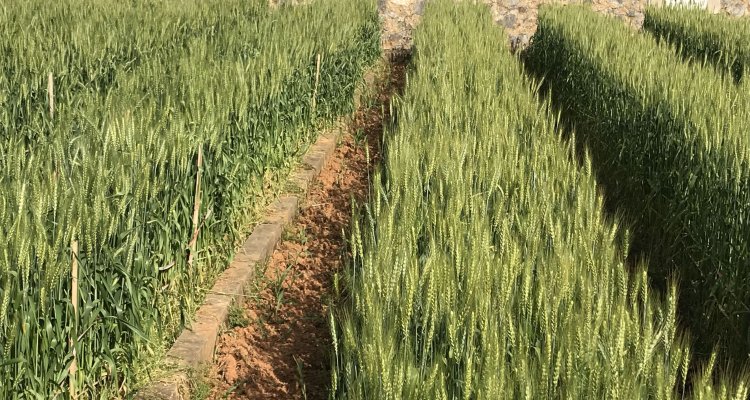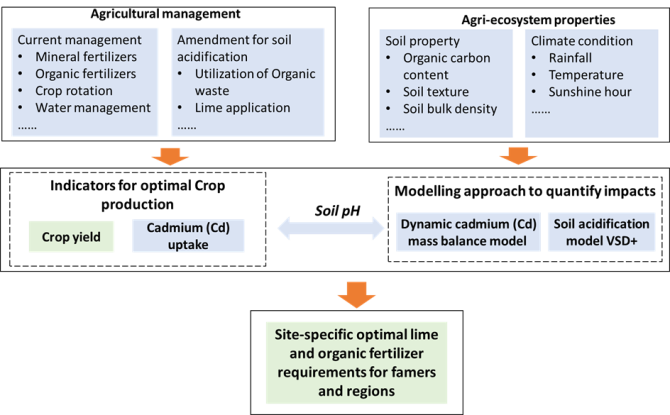
Project
Sustainable management of large-scale soil acidification and cadmium mobilization in Chinese croplands
Soil acidification is associated with various conditions restricting crop growth and enhances cadmium (Cd) bioaccumulation in crops and animals, threatening food safety and human health. Currently, around 40% of arable land in China is affected by soil acidity, mainly caused by improper agricultural management such as overuse of nitrogen fertilizer.
Objectives
This project aims to develop sustainable soil acidity management options for regional applications. This will be done by assessing: (i) the spatio-temporal variation of soil acidification of croplands in response to fertilization management (ii) the impacts of nutrient management scenarios on soil acidification and cadmium (Cd) crop uptake and (iii) optimal nutrient management to avoid soil acidity-induced yield losses and Cd uptake of main cereal crops. Mitigation strategies mainly focus on liming and replacement of chemical fertilizers by local manure resources. The project will be carried out in the Qiyang County of the Hunan Province. The project comprises four objectives:
- Assessment of long-term optimal nutrient management strategies to mitigate soil acidification and nutrient losses at field level
- Calculation of spatially explicit amounts and intervals of lime (base cations) to counteract the current and future acidification at county-level
- Assessment of impacts of various nutrient management scenarios on cropland soil acidification and cadmium mobilization in paddy soils at county-level
- Development of optimal strategies to avoid soil acidity-induced yield losses and cadmium (Cd) uptake of rice at county-level
Methods
Soil acidification and Cd pollution in response to agricultural management (fertilizer, lime and water management and crop rotation) and agri-ecosystem properties (e.g., soil organic carbon content and climate condition) will be quantified by a further developed and calibrated soil acidification model VSD+ and dynamic Cd mass balance model (see Figure 1 for The overall research approach). The models will be calibrated by comparing simulated and observed soil pH and soil Cd accumulation (fluxes in soil-crop system)in a long-term fertilization experiment and at county scale. Then the calibrated model will be applied to assess and predict spatial and temporal variation of soil acidification, soil Cd changes and related impacts on crop yield and crop quality at county scale in response various nutrient management strategies, including the combined application of mineral nitrogen, phosphorus and potassium fertilizers, organic manure and lime. Finally, the optimal liming strategy, combined with the application of mineral and organic fertilizers will be derived to keep the soil pH above a derived critical value in view of both impacts on crop yield and crop quality (using critical Cd concentrations in grain) and minimizing the nitrogen and phosphorus surplus to the soil. Overall, results will be used to develop a site-specific integrated mitigation strategy tool to avoid soil acidification for famers and regions.

More specifically, the activities are:
- Assessment of optimal management strategies to mitigate cropland acidification at a long-term fertilization experiment in Qiyang County
- Calibration of VSD+ model on observed trends in cropland soil pH levels
- Scenario analysis for the optimal management to counteract cropland acidification - Calculation of spatially explicit amounts and intervals of agricultural lime applications at county-level
- Calculation of lime requirement based on soil pH and pH buffering capacity at county-level
- Calculation of liming intervals based on current soil acidification rates at county-level - Assessment of impacts of various nutrient management scenarios on cropland soil acidification at county-level
- Evaluation of potential organic fertilizer resources for replacement of the chemical fertilizers in the county
- Assessment of the long-term impact of different nutrient management practices on soil acidification and crop growth - Assessment of impacts of various nutrient management scenarios on cadmium (Cd) mobilization in paddy at county-level
- Extension of VSD+ model with Cd distribution, including soil Cd accumulation and Cd uptake, which affected by soil properties including soil pH, soil organic matter content etc.
- Application of the updated VSD+Cd model to predict Cd contamination risk under different nutrient management practices - Optimization of lime and organic manure application to avoid soil acidity-induced yield losses and cadmium (Cd) uptake of major crops at county-level
Publications
- Xu, D., Q. Zhu, G.H Ros, M. Xu, S. Wen, F.S. Zhang and W. de Vries, 2023. Model-based optimal management strategies to mitigate soil acidification and minimize nutrient losses for croplands. Field Crop Research 292 (2023) 108827. https://doi.org/10.1016/j.fcr.2023.108827.
- Xu, D., Q. Zhu, G.H Ros, Z. Cai, S. Wen, M. Xu, F.S. Zhang and W. de Vries, 2021. Calculation of spatially explicit frequency and quantity of agricultural lime applications in Qiyang County, China. Science of the Total Environment. https://doi.org/10.1016/j.scitotenv.2021.150955.
- Xu, D., A. Carswell, Q. Zhu, F. Zhang and W, de Vries, 2020. Modelling long-term impacts of fertilization and liming on soil acidification at Rothamsted experimental station. Science of the total Environment 713. 136249. https://doi.org/10.1016/j.scitotenv.2019.136249.